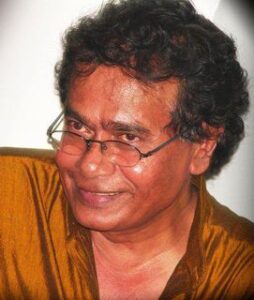Dharmasiri Bandaranayake

“The inner discipline of an individual and cultural development of a nation is greatly spurred by good art in every form – be it cinema, theatre, music or writing. In delivering this message, artistes become the most potent vehicle,” observes Dharmasiri Bandaranayake. In an interview with Nation, the celebrated dramatist and film-maker, urges revisiting our stage and the silver screen of yesteryear to reverse the present order.
we are so distant to social ethos. Who came forward to do a film or a drama on Rathupaswala tragedy? Will anyone come forward to give voice through art to the unfortunate young man from Empilitpitiya who is alleged to have been killed by police? An artiste should ideally create a social dialogue through these incidents
Q : How do you perceive the cinematic and theatre trend in the country in general?
I would say both these disciplines exist in a cultural and a social vacuum today. The dramatist and the film maker are very distant to the audience and as a result burning social issues don’t mirror in their work. Cheap art seems to hold sway today and television caters to it in abundance. Today many would prefer to invest in a tele-drama than in a film despite the substance or intellectual appeal. Television contributed immensely to the cultural development of the country since its introduction to the country until about two decades back. Even a tele-drama which was telecast had quality. Back then it was not a pawn in the hands of advertisers who would fight for ‘prime time slots’.
If this is a country which has never known anything better than the present state, we can be comforted, but a country which was capable of Gamperaliya and Maname cannot afford to fall into this abyss. Even our commercial films till about the early 90s had a finesse of their own. The commercial films done by the Serendib Company for example, such as Ranmuthu Doowa, Sarawita and Getawarayo had many features of artistic cinema which we don’t see today.
Q : In bridging this gap between the artiste and the audience, what lessons can we draw from the Indian experience, especially their cinema?
Indian film industry is two pronged: the Bollywood and the Tamil Nadu. If we discuss the Tamil Nadu film industry, it is strongly interwoven with society, even their commercial films. For example, they would not project the destruction of the family unit in their films because they don’t intend to see it destroyed. If a film is based on such a theme, it will be a failure there. Their industry is so socially-vocal, so much so even the Police fear it as it candidly projects their corruption! But in our case, we are so distant to social ethos. Who came forward to do a film or a drama on Rathupaswala tragedy? Will anyone come forward to give voice through art to the unfortunate young man from Empilitpitiya who is alleged to have been killed by police? An artiste should ideally create a social dialogue through these incidents.
Q :In your view what is the proactive role the Film Corporation could play in reviving the industry?
It should essentially be administered by people who are cinema-savvy and not politically-appointed henchmen. This was not the case during its heyday when administrators like Dr. DB Nihalsinha steered it. It is in need of people of his calibre who are knowledgeable about the industry and its needs. The 100 percent loan scheme and grading system, which launched several talented film-makers should be re-introduced. My film Thunweni Yamaya was produced on this loan scheme. People often ask me why I have not done a film since I did Bawa Duka and Bawa Karma in 1992. Who would invest? If grading system can be revived, the industry could benefit enormously.
Q :How important it is to move towards digitalizing of film theatres?
Today it is a dire need and this is the global trend but with so many theatres being closed down in the country, our cinema hall owners are not willing to invest a large sum in this facility. Today 54 films are awaiting release but it’s not easy because halls are owned by the private sector.
Q :Do you think the present Public Performance Board is more ‘liberal’?
Yes, very much so, but this liberty should not be exploited. Sadly democracy in this country is interpreted with a criminal psyche, therefore there is an onus on the cinema maker to have what is called ‘self-imposed censorship’. All great cinema makers in the world have practised this notion. To cut a long story short, by flaunting excess nudity in films, some of the films have been rejected by the audience itself. The audience itself will question ‘is this nude scene actually wanted?’ I think the most intense human sensuality can be expressed with subtlety.
Q :Today we see a mismatch between theatre productions and infrastructure. As a dramatist, what do you think is the way forward in overcoming this?
The best example I can give is the staging of Simon Navgaththegama’s Suba Saha Yasa on a make-shift stage in Debarawewa, made out of pol kotan. There was no hall to perform this drama but the audience was willing to stand and watch it before a humble stage erected in the middle of a kamatha. This was how our dramatists of yesteryear laboured to take their creations among ordinary people. Ironically as you said, at a time when theatre was close to the hearts of people, there were hardly any theatres in this country. Today we have Nelum Pokuna which is capable of bringing global productions closer to our people but sadly it does not happen. If it can become a theatre hub where at least three globally acclaimed productions could be brought close to our audience, it will truly personify its true purpose.

